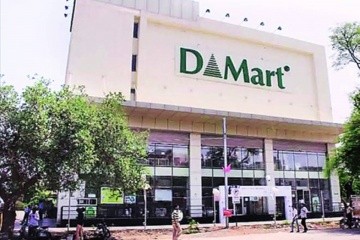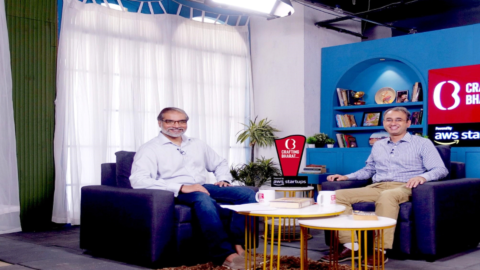Dmart, one of India’s leading retail chains, has become a household name, known for its commitment to offering quality products at affordable prices. The story of Dmart is a tale of humble beginnings, astute business strategies, and a relentless focus on customer satisfaction.
Founded by the legendary investor Radhakishan Damani in 2002, D’Mart has grown to become a retail giant with a market cap of $31.42 Billion (December 2023), outshining its competitors in the Indian retail market. This Success Story of DMart is a testament to the vision, dedication, and unwavering commitment of its founder, Mr. Radhakishan Damani.
The Early Days of Radhakishan Damani
Before he became the renowned entrepreneur behind D’Mart, Radhakishan Damani was already a celebrated figure in the world of investing and stock markets.
With a successful track record of picking value stocks and turning them into lucrative investments, Damani was well-respected in the Bombay Stock Exchange. However, he decided to embark on a new journey, one that would make him a legendary entrepreneur in the retail sector.
Radhakishan Damani’s journey began with a departure from his commerce degree after just one year. He joined his father’s ball bearings business and later delved into stock investments at the age of 32.
His keen insights and strategic investments led him to become one of the most influential stock investors of the 90s. He was even considered a mentor by renowned stock market investor Rakesh Jhunjhunwala, a testament to his exceptional skills.
The Birth of Dmart
In 2002, Radhakishan Damani decided to transition from a successful stock market career to entrepreneurship by founding Dmart.
What set Dmart apart from other retail chains was its unique approach to the Indian retail market. While many retail chains opted to lease their stores, Dmart meticulously conducted research and chose to own its stores outright across various locations in India.
This strategy proved to be a winning formula for Dmart, as they never had to shut down a single store since their inception. Unlike other retailers who diversified into electronics and fashion, Dmart remained focused solely on its core business of food and groceries.
Furthermore, while other supermarket chains launched their own private brands, Dmart exclusively stocked third-party products for its grocery section.
The Loyal Customer Base
One of the key reasons behind Dmart’s dedicated customer base is its commitment to providing low prices for Indian households. Every product in Dmart’s shelves comes with a minimum discount of 3%, making it a preferred choice for value-conscious consumers.
Dmart’s store decor is simple and unpretentious, even in urban areas like Mumbai, which appeals to a wide range of consumers. Additionally, the affordability of products at Dmart encourages bulk buying, creating a strong demand for their offerings.
Success Story of DMart : Strategic Approaches
Dmart aimed to create an image of a discount store that offered products from major brands at great value for money. They positioned themselves as a one-stop shop for all consumer needs, which contributed to their widespread appeal.

D’Mart operates in three different formats:
- Hypermarkets: These large-format stores, spanning 30,000-35,000 square feet, are strategically placed in high-traffic areas.
- Dmart Express: These smaller stores, covering 7,000-10,000 square feet, offer convenience in more localized areas.
- SuperCenters: Dmart’s largest format, these massive stores occupy over 1 lakh square feet.
The primary target audience for Dmart is the middle-income group, and they use discounts as a promotional tool to attract and retain customers. Dmart’s success is built on a strong foundation that encompasses three key stakeholders: customers, vendors, and employees.
D’Mart’s Growth Journey
Radhakishan Damani’s inclination towards consumer-based businesses was evident in his stock investments, and he envisioned venturing into the retail sector. In 1999, a time when organized retailing was still in its infancy in India, Damani took the bold step of entering this market.
He temporarily withdrew from the stock market for approximately six years, during which time he and his associate Damodar Mall acquired a 5000 sqft space for the ‘Apna Bazaar’ franchise in Nerul, Navi Mumbai. Soon, they expanded to multiple outlets and, ultimately, established Dmart, taking over Apna Bazaar as their own brand.
The early days of Dmart were marked by extensive learning about the retail market, understanding consumer preferences, creating a store chain, improving billing systems, and building trust with vendors.
Dmart’s conservative yet profitable approach reflects its founder’s personality. Radhakishan Damani is famously media-shy, rarely giving interviews, which adds to the mystique of D’Mart’s success.
Some Related Posts:
Wrapping Up
Dmart’s remarkable success story is a testament to the vision and dedication of Radhakishan Damani, who transitioned from a successful career in stock market investing to become an iconic entrepreneur in the Indian retail industry.
Dmart’s commitment to offering affordable prices, its strategic approach to store ownership, and its unwavering focus on its target audience have helped it become a dominant force in the Indian retail market.
As it continues to serve the needs of middle-income households and provide value for money, Dmart’s future remains bright, and its story serves as an inspiration for aspiring entrepreneurs in India and beyond.
Frequently Asked Questions(FAQs)
Q1: Who is Radhakishan Damani, and how did he start Dmart?
Ans: Radhakishan Damani is the founder of Dmart. He began his journey as a legendary stock market investor and later ventured into the retail sector, founding Dmart in 2002.
Q2: What sets Dmart apart from other retail chains in India?
Ans: Dmart’s unique approach involves owning its store locations outright rather than leasing them. It remains steadfast in its commitment to core offerings: food and groceries, and exclusively stocks third-party products.
Q3: How has Dmart managed to maintain its low prices for Indian households?
Ans: D’Mart offers a minimum discount of 3% on every product, making it a cost-effective choice for price-conscious consumers.
Q4: What are the different store formats used by Dmart?
Ans: D’Mart operates in three store formats: Hypermarkets (large stores), Dmart Express (smaller convenience stores), and SuperCenters (massive stores).
Q5: Who is Dmart’s primary target audience?
Ans: Dmart primarily caters to the middle-income group. Their strategy includes using discounts as a promotional tool to attract and retain customers from this segment.








[…] Success Story of DMart BharatPe Success Story The Man Company Success Story […]
[…] Mega Mart Success Story Success Story of DMart BharatPe Success […]
[…] Chai Sutta Bar Success Story Vishal Mega Mart Success Story Success Story of DMart […]